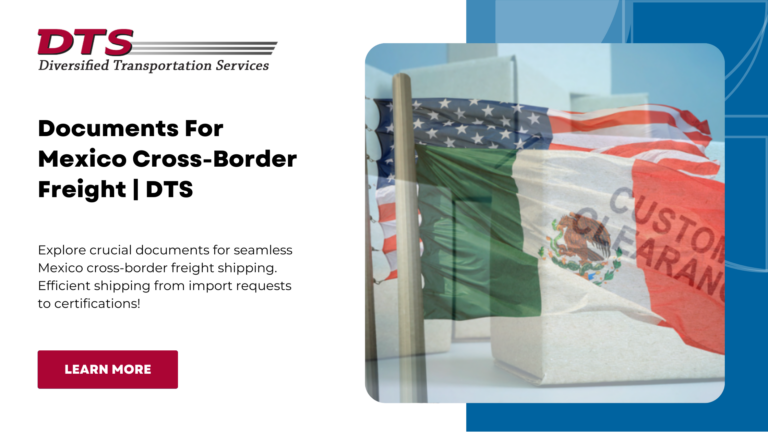
Proper planning is critical for any business involved in cross-border shipping to and from Mexico to help ensure your freight reaches its destination. Completing the right documentation is a key part of that but which documents do you need for freight shipping to Mexico?
We’ve previously covered Canada vs. Mexico customs requirements, where we discussed the main similarities and differences between the two. In this post, we’re diving a little deeper into the paperwork requirements for cross-border shipping between Mexico and the US.
Here are some of the essential documents required for Mexico cross-border freight.
The Mexican import request (or Pedimento de Importación) is required for any commercial crossing into and out of Mexico. This can be filed digitally with Mexican Customs.
With a Mexican import request, the relevant shipments can cross from the US into Mexico and undergo inspection as required. The request usually includes a description of the shipped items, their quantity, value, origin, and other important details.
A commercial invoice is a legal document between the party shipping the freight and the recipients. It’s used to quickly determine the appropriate customs duties and facilitate smooth shipping.
You should include the following information in your commercial invoice:
The commercial invoice for freight shipping to Mexico must be in Spanish.
The bill of lading covers the conditions under which a shipment is made. It must include essential details on the shipped products, such as the quantity, destination, and origin. The term Complemento Carta Porte (CCP) is often kept in Spanish in legal and logistics contexts but is sometimes referred to as the bill of lading complement. The CCP is an addendum required in Mexico for transporting goods and ensures compliance with Mexican tax regulations for the means of transportation.
The bill of lading is a legally binding agreement between the buyer and seller, and all parties involved must follow it. It’s considered to be a type of receipt and can serve as a title of ownership. That means a carrier may retain the goods until payment arrangements are settled.
A North American Free Trade Agreement (NAFTA) Certificate of Origin certifies that goods being shipped qualify for the “preferential tariff treatment accorded by NAFTA” (according to the Customs and Border Protection). Qualifying goods that originate in the US, Mexico, and Canada will receive reduced or eliminated duty.
The exporter needs to complete the NAFTA Certificate of Origin; subsequently, the importer should have it in their possession when they make the declaration.
When arranging cross-border shipping to Mexico, a packing list details the contents of the packages moving between countries, facilitating smooth transit.
A packing list should include:
This is usually checked alongside the commercial invoice to confirm that the contents match.
A shipper export declaration, now known as Electronic Export Information (EEI), is required for all cross-border freight shipments valued at $2,500 and above. This helps the Census Bureau record information on international trade.
Customs and Border Protection and the Bureau of Industry and Security also use this document to verify that the shipment complies with regulations.
Any products entering Mexico must be accompanied by the proper product safety documentation. This declares that the products being shipped comply with regulations and are safe to enter Mexico.
Several types of cargo are restricted or prohibited, including firearms and used clothing not in personal luggage.
Mexican truck drivers bringing cross-border freight into the US need a B-1 visa. To meet the general entry requirements, truck drivers must:
A B-1 visa is required even for brief journeys to and from the US.
If you plan to send goods to or from Mexico, your freight must be accompanied by the proper documentation. Without the right paperwork, you could encounter delays and fines that disrupt your operations. Understanding the different documents required for cross-border shipping to Mexico, and other aspects of transporting freight between countries can be difficult. As a trusted shipping and logistics company, we provide cross-border shipping solutions for shipments going to and from Mexico.
For more helpful advice and tips on efficient cross-border shipping, check out our blog. For a cross-border freight quote or advice, send us a message today.
Whether you're a company looking to improve one facet of your supply chain, your entire supply chain, or simply looking for a transportation and logistics consultation, we can help.